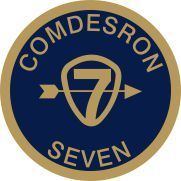Branch United States Navy Part of U.S. 7th Fleet | Type Destroyer Squadron | |
 | ||
Active 1920–22, 1939–45, 1946–present Country United States of America Role Naval surface/strike/anti-aircraft warfare | ||
Destroyer Squadron 7's (DESRON 7) mission is to conduct prompt, sustained operations at sea in support of United States national policy and maritime security objectives as part of Forward Deployed Naval Forces (FDNF) in U.S. 7th Fleet.
Contents
Lines of Effort
DESRON 7 is a tangible example of the Asia-Pacific Rebalance after shifting homeports from San Diego to Southeast Asia in December 2012 and is the first forward deployed DESRON command in Southeast Asia in more than 40 years.
The command leads the execution of the Cooperation Afloat Readiness and Training (CARAT) exercise series. CARAT is an annual bilateral exercise, now in its 21st year, and is the lifeblood of U.S. navy-to-navy relationships in Southeast Asia. During the 2014 CARAT season alone, DESRON 7 operated with more than 40 U.S. and international ships, embarked 12 U.S. Navy ships, and led bilateral task groups totaling more than 10,000 personnel. Additionally, CARAT included Seabees, Explosive Ordnance Disposal Technicians, medical professionals, diving experts, 50 U.S. and international aircraft, U.S. Marine Corps landing forces, and more than 150 days of interaction as we planned and exercised with our partners and allies.
DESRON 7 assumed tactical command of USS Fort Worth (LCS 3) on December 4, 2014. Building on the achievements of USS Freedom's (LCS 1) inaugural 10-month deployment to Southeast Asia from March to December 2013, Fort Worth will visit more ports, engage more regional navies during exercises like CARAT and expand LCS capabilities, including embarking and using the MQ-8B Fire Scout unmanned aircraft system. LCSs are optimally sized for the region’s geography and operate well alongside the small, but capable, ships of many Southeast Asian navies.
DESRON 7 has also successfully taken lead in conducting major exercises and events, to include Operations Guardian and Damayan, Foal Eagle, ANNUALEX and FST-J, and can provide permanent major command at-sea presence and serve as a sea combat commander for carrier strike groups when tasked. Additionally, the commodore served as the tactical commander of Fort Worth and USS Sampson (DDG 102) during the Indonesian-led search for AirAsia Flight QZ8501.
In a short period of time, DESRON 7 has made an immediate impact in Southeast Asia.
Recent Articles from DESRON 7
Assigned Units
DESRON 7 is in tactical command of USS Fort Worth (LCS 3), which is currently on a 16-month rotational deployment to the Asia-Pacific and operating from Singapore as its maintenance and logistics hub.
Command History
DESRON 7 was first established in September 1920 as a reserve squadron of 15 ships home-ported at Charleston, South Carolina. The squadron was deactivated from July 1922 until April 1939 when it was reorganized in San Diego, California.
In December 1940, the squadron was reformed at Newport, Rhode Island and, until the end of the European War, was actively engaged in escort duties throughout the Atlantic and Mediterranean Theaters. In May 1945, the squadron was reformed at San Diego, California and operated with Pacific Fleet for the remainder of World War II.
In November 1945, the squadron was deactivated and in January 1946, DESRON SIXTY was re-designated DESRON 7. Ships of the squadron participated in the atomic bomb tests at Bikini Atoll and saw extended action during the Korean War, including the invasion of Inchon. During the Vietnam conflict, the squadron again saw action on the Market Time patrol and engaged in the bombardment of North Vietnam.
In January and February 1979, the squadron participated in the evacuation of Americans from Iran. During Operation Desert Storm, COMDESRON SEVEN saw extensive combat action. As the North Arabian Gulf Local Anti-Surface Warfare Commander, COMDESRON SEVEN directed multi-national forces in offensive operations which eliminated the Iraqi Navy.
In May 2004 COMDESRON SEVEN embarked USS RONALD REAGAN, the Navy’s newest aircraft carrier, to serve as the Sea Combat Commander for the RONALD REAGAN STRIKE GROUP. As Sea Combat Commander, the DESRON was responsible to the Strike Group Commander for the overall planning and execution of maritime operations including Surface and Subsurface Warfare, Maritime Interdiction Operations, Mine Warfare, and Force Protection.
In December 2012, COMDESRON 7 executed a historic homeport shift to Southeast Asia in support of America's Rebalance to the Pacific. COMDESRON 7 is currently tasked as tactical commander of Littoral Combat Ships (LCS) rotationally deployed to Singapore, and also leads the execution of the entire Cooperation Afloat Readiness and Training (CARAT) series for Commander, Task Force 73.
